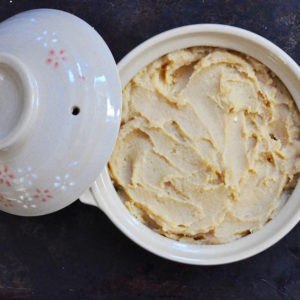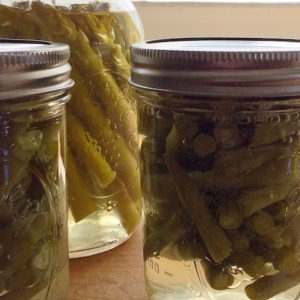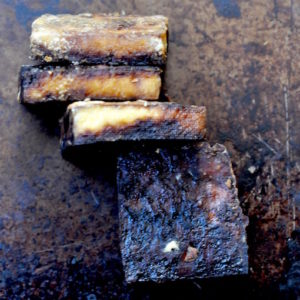Miso Steak with Noodles
This is a fermented paste made from soybeans and grains, and it is used as a base for sauces and soups. Look for it in Japanese groceries or natural foods stores.
Mollie Katzen, defining miso in The Enchanted Broccoli Forest.
Until the early aughts, most Americans knew miso as the small bowl of soup served in Japanese restaurants, before the sushi. More adventurous eaters might buy instant miso soup in packet form: empty the tan powder into a cup, add hot water, stir. Voilà: miso soup.

(I don’t have any instant miso soup to take a picture of. May I offer this bland seascape instead?)
Now people are dolloping miso into everything. A cursory internet search pulled up recipes for miso hummus, miso mayo, salted-miso-chocolate-chip cookies, miso mac-n-cheese, miso-tahini avo toast, and edamame-miso-tuna sandwiches.

(Right before taking this picture I wolfed down a breakfast burrito. I was attending a “vintage faire” in a building to the right of this vista. There wasn’t a dollop of miso in the vicinity. The burrito was fine without it.)
Is it me, or do salted-miso-chocolate-chip cookies sound nauseating?

Miso is indeed a useful ingredient with great depth of flavor (the “u” word having sent, well, word that it will strike if associated miso even once more.) But all too often the quest for novelty eclipses reason. Or as Diana Henry put it when I saw her speak at Omnivore Books last month: “Whatever happened to deliciousness?”
Good question. On that note, Miso steak with noodles was inspired by a cook with a deep understanding and great respect for miso. Nancy Singleton Hachisu is a native Californian now living in Japan, where she has devoted her life to the study of Japanese artisanal foodways. In Preserving The Japanese Way, Hachisu explains the varieties of miso and even offers instructions for making it at home.

Many of Hachisu’s recipes utilize miso as a marinating or pickling medium for beef, poultry, and vegetables. Inspired, I spackled two thick steaks with miso and left them overnight. At cooking time, I cut the meat into what Fuchsia Dunlop calls “chopstickable” slices and stir-fried them. The results were wonderful: subtle, deeply flavored meat that wasn’t least bit salty.

While this dish would work with rice, it cries out for noodles. I like the Japanese soba noodles meant for stir-frying, but Udon or any other thick, chewy noodle would work just as well.

It is high summer as I write, so this meal was served with sliced raw tomatoes, drizzled with soy sauce.

Dressing tomatoes with soy sauce is another Nancy Hachisu idea, and it is an excellent one. In Preserving The Japanese Way, she recommends Ohsawa Organic Nama Shoyu soy sauce. At $10 for 10 ounces, Ohsawa Organic soy sauce isn’t cheap. Use it for finishing a dish as you would a fine olive oil or fancy sea salt, and a bottle will last a long time.

Once you’ve got your meat marinated, miso steak with noodles comes together quickly. Leftovers, if you are lucky enough to have any, keep nicely for a few days in the fridge.

Miso Steak with Noodles
Yield: 2 servings, easily scaled upward
Preparation Time: 4-24 hour marination time for the meat. Actual cooking time: about ten minutes
For the marinade:
one pound/464 grams steak: flank, tri-tip, or thicker cuts of lean stir-fry steak are good; see notes for discussion of cuts
2 tablespoons Shiro or white miso
To cook the dish:
About two tablespoons peanut or other high heat flavorless oil like canola, for the wok
2-3 large garlic cloves, peeled and thinly sliced
2 scallions, trimmed and sliced into thin rings
2-3 teaspoons regular soy sauce (not “lite”)
salt, as needed
sesame oil, to taste
slivers of fresh scallion, optional
soba, Udon, or other thick noodles, as desired; we use about 12 ounces
sliced tomatoes lightly drizzled with soy sauce or vegetables of your choice
Miso steak with noodles is ideally prepared using a 14-inch wok. Lacking a wok, use your largest, heaviest frying pan. It is better to cook the meat in batches rather than crowd the pan. A crowded pan will result in unevenly cooked meat and food on the floor. I speak from experience.
Marinate the steak:
4-24 hours before cooking, evenly smear about two tablespoons of miso all over the meat. This is a messy job; just do the best you can. Place steak in a baking pan or lidded food storage container, cover, and refrigerate.
An hour before you plan to cook, remove steak from the refrigerator so it can come to room temperature.
Slice the garlic. Trim and slice the scallions.
Slice the steak into pieces easily managed with a fork or chopsticks. You don’t need to wipe off the miso.
Heat a 14-inch wok or large, heavy bottomed frying pan over high heat. Add about two tablespoons cooking oil. Allow it to heat.
Turn heat down slightly. Add the garlic and scallion and stir-fry for about 30 seconds. Add steak to the pan, then the soy sauce, stir-frying continuously, 4-5 minutes, depending on the cut of steak and heat of your pan. If you aren’t sure whether the meat is fully cooked, either taste it or cut into a piece.
If your pan is small, divide steak and soy sauce into batches, removing the first batch to a plate.
Also taste for seasoning: the dish may need additional soy sauce. It will likely need salt.
Remove steak to individual bowls or a large platter and add sesame oil to taste.
Make noodles according to package directions (Asian style noodles take moments to prepare). Place in the bowls or arrange on platter with steak. Top with slivered fresh scallions, if desired.
Serve with tomatoes drizzled with soy, or seasonal vegetables, raw or stir-fried, of your choice.
Eat.
Notes:
This recipe works with thicker cuts of steak. My market sells what they call “family pack tri-tip steaks” in packages. This is a tough, cheap, flavorful cut that has some marbling but isn’t over fatty.
Miso steak with noodles keeps, refrigerated, in a covered container up to five days. While you could freeze the meat, any remaining miso would become gluey. So would cooked noodles.
Western supermarkets usually sell two to four different kinds of miso. This dish uses “white” or lighter miso. A tub of miso will keep indefinitely refrigerated.

As I was writing this post, the food world lost two great talents. French native Madeleine Kamman was a teacher and writer whose memoir, When French Women Cook, is a moving, beautiful book chronicling French life just before, during, and after World War II.
Jonathan Gold was only fifty-seven when he died last week from pancreatic cancer. An early champion of “ethnic” eateries and immigrant cooking, Gold was the first person to win a Pulitzer Prize for food writing.
Both are enormous losses.




